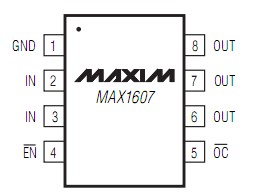MAX1607: Features: Pin Compatible with TPS2014, TPS2015, and TPS2041Accurate Current Limit (0.7A min, 1.0A max)Guaranteed 0.75A Short-Circuit Protection10ms Internal OC Blanking TimeoutNo Overcurrent (OC) Si...
floor Price/Ceiling Price
- Part Number:
- MAX1607
- Supply Ability:
- 5000
Price Break
- Qty
- 1~5000
- Unit Price
- Negotiable
- Processing time
- 15 Days
SeekIC Buyer Protection PLUS - newly updated for 2013!
- Escrow Protection.
- Guaranteed refunds.
- Secure payments.
- Learn more >>
Month Sales
268 Transactions
Payment Methods
All payment methods are secure and covered by SeekIC Buyer Protection PLUS.

 MAX1607 Data Sheet
MAX1607 Data Sheet







